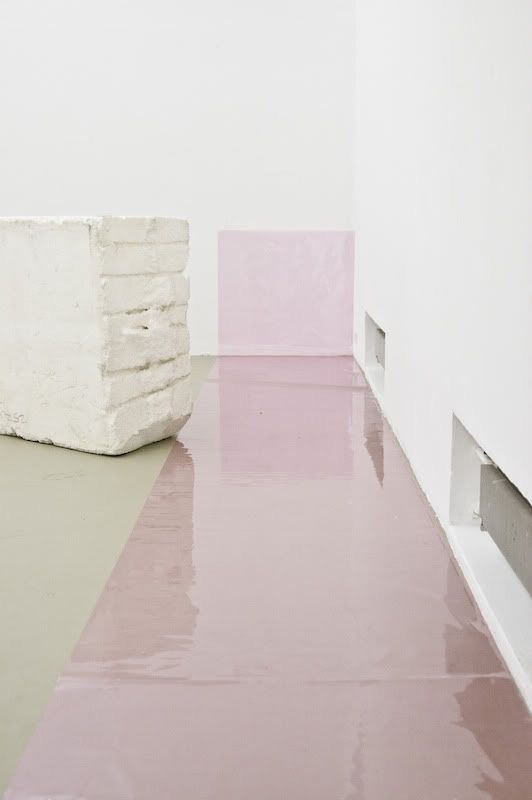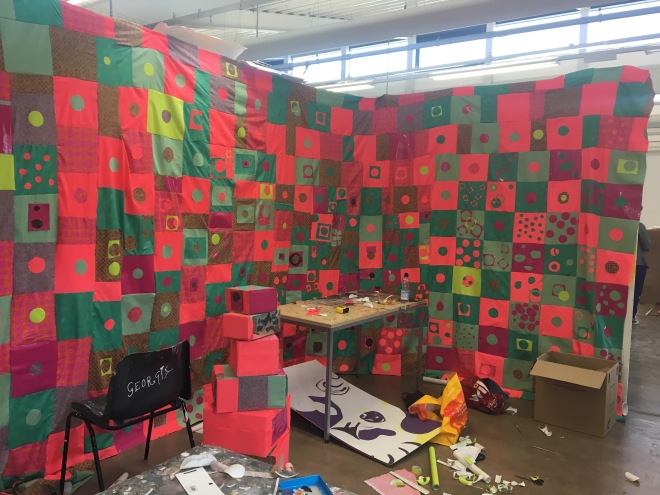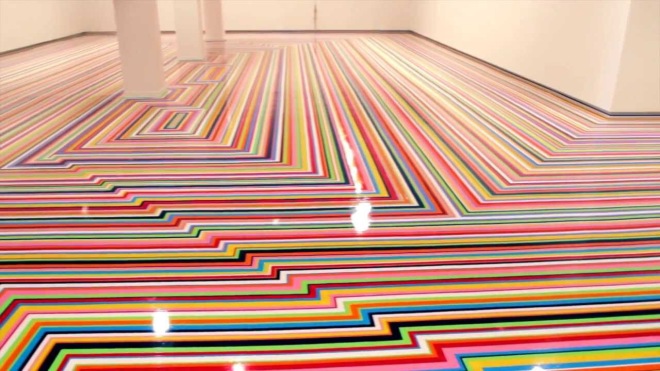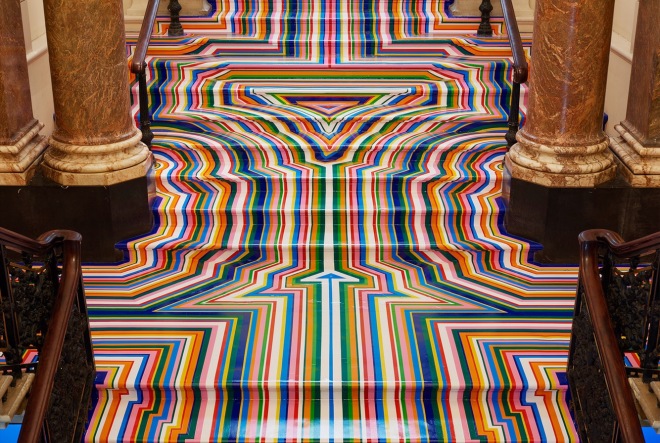I have added a neon green/yellow fablon into my piece to add another dimension through colour. I feel this works well with the colours previously used.
Category: Field
Ian Kiaer
Ian Kiaer studied at the Slade School of Art (1995) and the Royal College of Art MA (2000); PhD (2008). Kiaer works within painting, sculpture, found-objects, and installation. Ian Kaier’s most known works are installation spaces. His installations explore social interaction with the constructed environment, relating to utopian ideals and their failure.
I am looking at Ian Kiaer’s installation pieces as I am interested in his use flooring that he adds to a piece. I have noticed how Kiaer takes deep thought in choosing a flooring or surface based on the work he is making. Kiaer has used coloured flooring in some of his installations, this can be subtle or very bold and purposeful depending on the space he is trying to convey.
I am hoping to create a surface to my installation space, I want something that is bright and empowering. Also something that will help to bring out colours in my patchwork surrounding. I am also interested in making the surface reflective by either using a mirror or a high gloss, so that the colours bounce off the surface to create a highly saturated and overpowering space.
 Ian Kiaer ‘Limp Oak’ at Lulu Mexican City. Installation. 2015
Ian Kiaer ‘Limp Oak’ at Lulu Mexican City. Installation. 2015 
Finishing the patchwork
Patchwork Display prep 2
And it’s touching the floor. So from the last time I visited the studio I have expanded the fabric so that it is now to the floor. Although, I’m thinking of adding an extra row of squares/ rectangles to the bottom just so that when the patchwork is lifted it definitely reaches the ground.
I am currently working on the piece to add to this and it will hopefully be done by the time I go back for third term. As I am hoping to be finished with the patchwork by then so that I can concentrate on the less time consuming but just as important elements to my installation. Something I am curious about is whether I’ll need to paint the studio wall for this piece, as this is only prototype pinned I can see the wall where the patchwork stretches across the corner and I am wondering whether this will happen when it is tacked properly. If so I may paint the parts that do show a muted colour so that it doesn’t take the attention away from the piece. This is something I will discuss with my tutor when I go back for third term.
Mirror Installations
Patchwork display prep
Today was the first time hanging the larger scaled patchwork. I was surprised with how big it actually was and felt the effect on the eye was rather intense even with just the studio lighting so I was pleased with that.
Although there are many alterations and improvements I need to develop on. I need to make the patchwork around 3 square rows longer so that the patchwork touches the floor and I also want to be able to pin the nails on top on the studio walls so that there are no visible nails in sight. Again with size, I measured how much bigger it needs to be to fill 3 walls and I need to create another 8 by 11 rows of patchwork to add to this piece. The bigger it’s getting the more difficult it is to sew together. Although tacking it with pins etc has helped with this. A problem I am facing is that, due to the weight of this piece where I have placed nails into the patchwork it is putting strain on the materials and I am find holes and rips caused by the piece being so heavy. Although this can be easily sorted by using a hand stitch in places that are needed.
So far I have spent averagely £130 on fabric for this piece.
Installation Art
What is installation art? Installation art is used to describe large-scale, mixed-media constructions. These are usually site specific or only made for a certain period of time due to being such a large scale. I am making an installation space for the degree show, therefore I thought I would explore different types of artists who create installation art.
Toshiko Horiuchi MacAdam
Playground Crochet (1990)
Toshiko creates large installation ‘playscapes’ using crochet. She allows people to play and experience the playground like installations. Her work is fun and interactive. I want mine to have a playful feel to my work as viewers can move the boxes with they wanted to change the shapes of the centre structures.
Barry McGee. They Don’t Make This Anymore. (2008.)
Barry creates installation from his interest in Graffiti Culture and wants his work to echo the city. I am interested by Barry’s use of colour and shape that cast an illusionistic visual.
Sarah Sze
Triple Point (2013)
Sarah creates spaces using found objects and everyday ordinary things to create site-specific art installations. Sarah Sze’s intricate pieces create a new sense of space almost like a solar system.
Megan Geckler
Geckler is a Site Specific installation artist who uses flagging tape (plastic ribbon) to make large scale installation spaces. She uses the architecture around her to form the shape of her installations.
When I first saw Geckler’s work I was instantly attracted to the neon colours that create optical illusions especially when they are weaved together you would think they were a solid thing and not a combination of layered tapes. I like how the tape almost forms it’s shape itself when wrapped around a structure. Geckler uses spaces that portray intense lighting so that the colours of the tape are as luminous as possible. Something I will need to consider when planning my exhibition space is the level of lighting as ideally I would like a space where I am able to get natural lighting through a window, but also near artificial lighting. Also the option to add spot lights for extra brightness so that the colours I use are intensified.


Display Planning-What i am creating
For my exhibition I am aiming to create an installation piece made from patchwork. I want to create an installation piece as I want the patchwork to surround the viewer for it to be more impacting, rather than being stuck on a wall to view. I want the patchwork to fill 3 interfacing walls to create an overpowering environment. To add to this I will be adding stacked boxes also covered in the same patchwork so that the overall space is hard to look at and clashing. I want to add a reflective surface to some of the boxes and the floor so that the patchwork is further reflected. I am also thinking of using either a reflective ceiling or a coloured plexiglas ceiling the add an extra colour to the overall environment. I am also interested in the lighting being more intense than just the studio lighting so that the colour is more saturated for the viewer.
Jim Lambie
Jim Lambie ‘Selected Floors.’
After my last tutorial with David he suggested I looked at the artist Jim Lambie. Lambie is a Scottish Artist who’s practice evolves from a response to the psychology of space and colour. He is mostly influenced by movements in art and the history of place. I was advised to look at his work as my current practice revolves around colour and the finish of different fabrics.
I am considering making a floor like this for my final exhibition space. But maybe with less colours or one solid colour. I also want the finish to shine similarly to Lambie’s flooring so that it really reflects any light that is above the space I am given.













